|
|
 |
|
Calanoida ( Order ) |
|
|
|
Calanoidea ( Superfamily ) |
|
|
|
Paracalanidae ( Family ) |
|
|
|
Bestiolina ( Genus ) |
|
|
| |
Bestiolina mexicana Suarez-Morales & Almeyda-Artigas, 2016 (F, M) | |
| | | | | | | Ref.: | | | Suarez-Morales & Almeyda-Artigas, 2016 (p.302, Descr. F, M, figs. F, M, Rem.) | 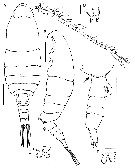 Issued from : E. Suarez-Morales & R.J. Almeyda-Artigas in Rev. Mex. Biodiiv., 2016, 87. [p.303, Fig.1]. Female (from 19°12'55.2''N, 96°04'36.0''W): A-B, habitus (dorsal and lateral, respectively); C, rostrum (semi-lateral view); D, 5th pedigerous somite with row of spinules (arrowed) and urosome (lateral); E, P5 (vebtral view); F, P5 of one paratype specimen showing slight asymmetry. Scale bars: A, B = 100 µm; C-F: 10 µm; D: 50 µm. Nota : Cephalosome and pediger 1 separate, pedigers 4 and 5 separated dorsally. - Rostral projections thick, strongly developed. - Posterior corners of 5th pedigerous somite rounded, bearing rows of minute spinules. - Urosome 4-segmented. - Genital double-somite symmetrical in dorsal view, with moderately expanded outer margins ; somite strongly protuberant in lateral view - Anal somite slightly shorter than preceding 2 urosomites together. - Caudal rami symmetrical almost as long as anal somite, each ramus bearing 5 caudal setae, innermost shortest. - A1 23-segmented, reaching midlength of anal somite. - P5 reduced, represented by pair of symmetrical rounded lobes (some specimens with slight asymmetry, one lobe being smaller.
|
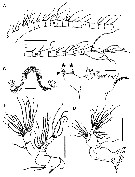 Issued from : E. Suarez-Morales & R.J. Almeyda-Artigas in Rev. Mex. Biodiiv., 2016, 87. [p.304, Fig.2]. Female: A, A1 (segments 1-14); B, A1 (segments 15-23); C, labrum (ventral); D, Md with palp; E, gnathal blade with dentition (supplementary monocuspidate teeth indicated by asterisks); F, A2. Scale bars: A, B: = 100 µm; c, e = 10 µm; F, D = 50 µm. Nota : A1 23-segmented (ancestral segments II-IV and XXVII-XXVIII fused ; armature : s= seta, ae = aesthetasc, sp = spine ; I-IV-7s +ae, V-1s=ae, VII-1s+ae, VIII- 1s+ae, IX-1s+ae, X-XI 1s+ sp, XII-1, XIII-1s+ae, XIV-1s, XV-1s, XVI-1s, XVII-1s+ae, XVIII-1s, XIX-1s, XX-1s+ae, XXI- 1s+ae, XXII-1s, XXIII-2s, XXIV-2s, XXV-2s, XXVI-2s, XXVII-XXVIII-4s+ae). - A2 with short, subquadrate coxa, separated from basis by complete suture, bearing short, lightly setulated seta. Basis with 2 unequally long distal setae. Endopod 2-segmented, 1st segment with 2 unequally long setae and row of spinules along distal margin, 2 nd segment bilobed, subterminal lobe with 9 setae, apical lobe with 6 setae. Exopod 8-segmented, segments 2-4 partially fused, with incomplete suture ; esgments 1-7 each armed with 1 seta, terminal segment with 4 apical setae. - Labrum well developed, bordered by row of strong spinules arranged in tight pattern. - Md with gnathal blade heavily sclerotized, with 4 strong medial teeth, dorsal teeth bicuspidate, large anterior tooth separated from main blade by wide diastema, tooth furnished with pair of strong secondary monocuspidate teeth (asterisks in fig.2 E). Palp biramous, basis with 4 subequal setae. Exopod relatively short, 5-segmented, setal formula 1, 1, 1, 1, 2 ; Endopod 2-segmented, 1st segment with 4 subequal setae, 2 nd segment with 11 setae.
|
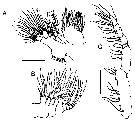 Issued from : E. Suarez-Morales & R.J. Almeyda-Artigas in Rev. Mex. Biodiiv., 2016, 87. [p.305, Fig.3, A-C]. Female: A, Mx1; B, Mx2; C, Mxp. Scale bars: A-C: 50 µm. Nota : Mx1 praecoxal arthrite bearing 14 setal elements on anda round distal margin, 4 of them setiform, 10 stout, spiniform. Coxal endites armed with 3, 3 setae, respectively ; coxal epipodite with 9 setae. Basis with 4 setae on endite. Endopod and exopod with 14 and 11 setae, respectively. - Mx2 with well-seveloped, subquadrate praecoxal endite armed with 5 setae, 2 succeeding coxal endites each armed with 3 setae. Basis with 4 setae. Endopod 3-segmented, 1st segment with 1, 2 nd with 3 and small terminal segment with 5 setae, 3 of them apical. - Mxp slender, relatively long, with elongate syncoxa, armed with 4 groups of setal elements, proximalmost wit 1, 2 nd with 2, 3rd with 3, and distal most group with 4 setae : rows of minute spinules at insertion of 2 nd and 4yj setal groups. Basis with 5 setae. Endopod 6-segmented, setal formula 2, 3, 3, 2, 4, 4.
|
 Issued from : E. Suarez-Morales & R.J. Almeyda-Artigas in Rev. Mex. Biodiiv., 2016, 87. [p.306, Fig.4, A-D]. Female: A, P1( with endopod separate); B, P2; C, P3; D, P4. Scale bars: A-D: 50 µm.
|
 Issued from : E. Suarez-Morales & R.J. Almeyda-Artigas in Rev. Mex. Biodiiv., 2016, 87. [p.304]. Female: Spine and setal formula of swimming legs P1 to P4.
|
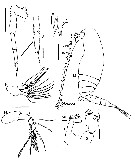 Issued from : E. Suarez-Morales & R.J. Almeyda-Artigas in Rev. Mex. Biodiiv., 2016, 87. [p.305, Fig.3, D-J]. Male: D, habitus (lateral); E, rostrum (semi-lateral view); F, Md palp; G, A2 (a: exopod, b: detail of 2nd endopodal segment); H, Mxp; I, P5; J, detail of distal and subdistal segments of P5. Scale bars: D, 100 µm; E, G a, b, J = 10 µm; F, H, I = 50 µm. Nota : Cephalosome and pediger 1 fused, pedigers 4 and 5 separated. - Posterolateral marginsof 5th pediger rounded, with row of minute spinules. - Rostral projections thick, tapering distally, as in female. - Ueosomewith 5 somites. - Caudal rami symmetrical, about 2 times longer than wide, armed with 5 caudal setae ; inner margins of rami slightly setulated - A1 18-segmented, extending to distal part of 2 ndurosomite (ancestral segments I-IV, V-VIII, and IX-X fused). - A2 biramous, coxa and basis completely fused with simple seta ; endopod 2-segmented, 1st segment unarmed, 2 nd segment bilobed, ornamented with row of spinules on distal margina at insertion of apical setae. Subdistal lobe with 4 setae, 3 of them apical, 1 subapical ; distal lobe armed with 5 setae ; exopod incompletely fused, armed with 5 setae. - Md coxal gnathobase absent, basis armed with short papilliform seta ; exopod 2-segmented, armed with 6 setae, with partial sutures (arrowed in fig.3, F ) ; endopod 2-segmented, 1st segment unarmed, 2 nd endopodal segment with 8 setae. - Mxp reduced, 4-segmented, including long, robust syncoxa, shorter subrectangular basis plus 2-egmented endopod. Syncoxa naked, basis with short seta. 1st endopodal segment with 3 setae, outermost being thick, bipinnate ; 2 nd segment with 4 setae, 2 of them thick, bipinnate. - P5 strongly asymmetrical ; right leg as in female, represented by rounded lobe ; left leg elongate, 5-segmented, almost as long as urosome. Penultimate segment with pointed process on distal margin ; distal segment with short spiniform process and long, slender apical spine.
|
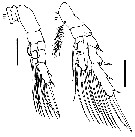 Issued from : E. Suarez-Morales & R.J. Almeyda-Artigas in Rev. Mex. Biodiiv., 2016, 87. [p.306, Fig.4, E-F]. Male: E, P1; F, P2. Scale bars: E, F = 50 µm.
| | | | | NZ: | 1 | | |
|
Distribution map of Bestiolina mexicana by geographical zones
|
| | | | Loc: | | | NW Atlant. (Gulf of Mexico, Veracruz, Laguna de Mandinga).
Type locality: 19°02'55.2'' N, 96°04'36.0'' W. | | | | N: | 1 | | | | Lg.: | | | (1199) F: 0,65-0,69; M: 0,63-0,67; {F: 0,65-0,69; M: 0,63-0,67} | | | | Rem.: | For Suarez-Morales & Almeyda-Artigas (2016, p.308) the new species is the firsrt member of the genus described from the Atlantic Ocean. Based on the zoogeography analysis (see Moon & al., 2010), it is clear that the genus Bestiolina had its radiation core in the Indo-Malaysian region.
The specimens examined were identified as Bestiolina because of the lack of serration on the outer margins of the 2nd and 3rd exopodal segments of P2-P4, a reduced female P5 represented by a pair of simple lobes and an asymmetrical male P5 with the left ramus as in female, with a rounded lobe and a long, 5-segmented left leg furnished with a short apical spiniform process and a relatively long, slender spine.
When running the identification key (Moon & al., 2010), B. mexicana down to the couplet B. zeylonica/B. sinica regarding the presence or absence of spinules on the exopodal segments 1-3 of P2; the new species has spinules on the 1st segment only, so far a unique character among the known species of the genus. The new species can be readily distinguished from B. similis by the structure of the rostrum, which has long, slender rostral filaments, thus contrasting with the relatively strong, stout rostral projections of the new species. The new species has some reductions in the armature of A1 and interesting apomorphies like the supernumerary teeth on the gnathal blade but also a reduced set of ornamentation on P2-P4, which contrast with the regular dentition and the richer spinulation patterns found in the Asian species.
The finding of B. mexicana strengthens the notion that Asian coastal/estuarine forms had successful interoceanic dispersal processes and were able to colonize the Northwestern Atlantic as a result of pre-Pliocene conditions. | | | Last update : 19/06/2023 | |
|
|
 Any use of this site for a publication will be mentioned with the following reference : Any use of this site for a publication will be mentioned with the following reference :
Razouls C., Desreumaux N., Kouwenberg J. and de Bovée F., 2005-2025. - Biodiversity of Marine Planktonic Copepods (morphology, geographical distribution and biological data). Sorbonne University, CNRS. Available at http://copepodes.obs-banyuls.fr/en [Accessed December 29, 2025] © copyright 2005-2025 Sorbonne University, CNRS
|
|
 |
 |









